The 13 Most Beautiful Urban Hikes in America
Hiking and living in a vibrant city are no longer mutually exclusive. From Los Angeles to Atlanta, you don’t have to leave the city to get dirty on these nearby trails.
Heading out the door? Read this article on the Outside app available now on iOS devices for members! Download the app.
I seek out urban hiking trails in every city I visit. It may be a happy side effect of the global pandemic or the result of city planners shifting to focus on quality of life, but urban hiking is a legitimate thing now. No longer does living in a big city mean ditching the great outdoors, as nonprofits like the Trust for Public Land work harder to protect wild spaces within our largest cities, and trail builders work to squeeze dirt paths into surprisingly rugged patches of forest between concrete canyons.
Now, you can start a 358-mile thru-hike from the George Washington Bridge in Manhattan—on an actual trail. In San Francisco, urban hiking trails are so prevalent that there’s a guide company called Urban Hikers that focuses entirely on treks within their own city. In Chicago, groups can arrange for a city van to take them to nature preserves on the outskirts of town.
This kind of accessibility to the outdoors is more important than ever. Consider the environmental implications of being able to ditch the car and walk or ride a train to the trailhead. Think about outdoor equity and accessibility and the mental and physical health implications of having the opportunity to hike so close to home.
With that in mind, here are our 13 favorite urban hikes in the U.S.
1. New York City
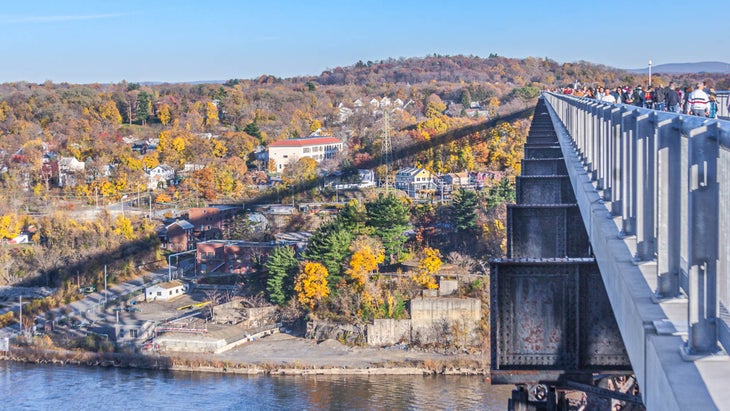
There are 51 nature preserves within the city’s five boroughs, protecting salt marshes, forests, and meadows. All in, the city has more than 12,000 acres of natural areas. You can walk the entire length of the Hudson River on a trail now—750 miles from New York City to Canada on the Empire State Trail.
I consider The Long Path to be the Empire State Trail’s wilder cousin, offering 358 miles of mostly singletrack from New York City to Albany. A particularly fun 11-mile section runs along the cliffs above the Hudson River starting at the end of the George Washington Bridge. The trail is rolling and rocky and offers a number of views of the river below and the city skyline. It’s arguably the most technical hiking in the city, and you can pick it up from 175th Street, making it very accessible.
2. Chicago, Illinois

Chicago has no shortage of open space. A complex of public forests sits to the west of town while the east side of downtown butts up against Lake Michigan and the 18.5-mile-long Lakefront Trail. An extensive trail system connects some of Chicago’s most popular parks, but most of those trails are paved, which is fine if you’re a roller blader, but less ideal if you crave a hike.
The exception to the rule is the North Branch Trail, a 16-mile mostly paved greenway that traces the North Branch of the Chicago River, linking together several of Chicago’s urban forests. While the main trail is paved from point to point, there’s an eight-mile unpaved alternate trail that starts just south of the Skokie Lagoons following an old dirt bridle path. It’s a hard packed surface without much elevation change, but it gets you closer to the river than the paved version.
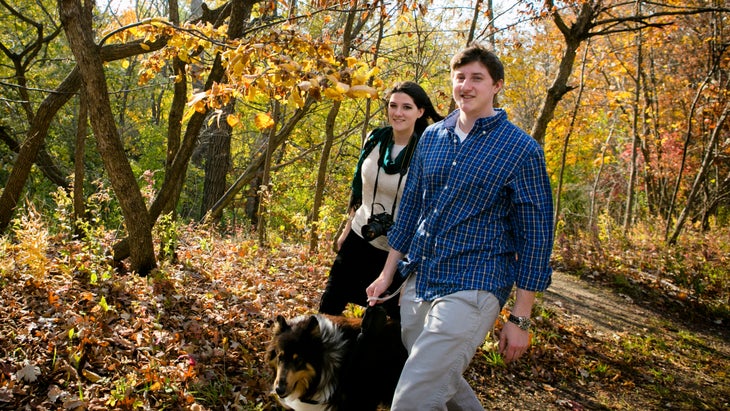
More importantly, it will deliver you to more primitive side trails that explore various pocket forests along the way. Check out the 1.2-mile Brown Loop Trail, which rings a horseshoe around Harms Flatwoods Nature Preserve, meandering through the 107-acre forest that’s characterized by its pancake-flat terrain and pocket wetlands.
3. Los Angeles, California
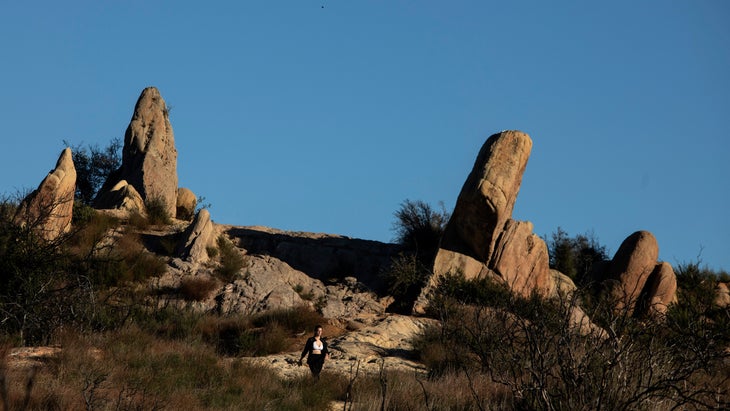
You know the reputation—Los Angeles is a city of cars and stars. Everything is paved and the traffic is horrendous, right? Yes, but that concrete jungle is flanked by 10,000-foot mountains to the east and a dramatic coastline to the west. The city is so big, it holds 25 different state parks and state beaches within its limits. That’s a lot of wild space within the concrete jungle. There’s even a long-distance backpacking trail— the 69-mile Backbone Trail—that traverses the Santa Monica Mountains, connecting many of those state parks. There are a few campsites along the trail, but most people break the Backbone up into section hikes.
If you don’t have time to thru-hike the Backbone, tackle the seven-mile section from Lois Ewen Overlook trailhead to Trippet Ranch in Topanga State Park. This section is all singletrack and takes you along Fossil Ridge—where you’ll find remnants of sea creatures stuck in the rock outcroppings—and climb Hondo Canyon, a dramatic gorge of purple-hewed sandstone. This section also has views of the ocean from rocky outcroppings, stretches through broad meadows, and a bit of recent history as you pass by former cattle ranches.
4. Austin, Texas
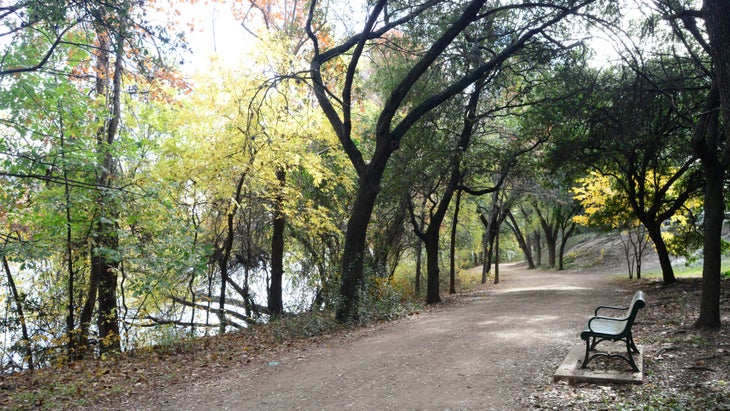
Keep Austin weird? The slogan should be “Keep Austin wild.” The most fun city in Texas has 60 miles of urban trail within its borders, and more importantly, Austin has funded a program designed to build out a more comprehensive network of paths for pedestrians and cyclists, that will almost double trail mileage in the next 15 years. You can already walk ten miles around Lady Bird Lake on the Roy Butler Hike and Bike Trail. Or pack a picnic and climb the 102 steps up Mount Bonnell for the sunset view. You can tackle the hills and climb the limestone cliffs along the Barton Creek Greenbelt. There are parks in every corner of Austin, all within walking distance of some of the best barbecue and tacos in the state.
If you want more of a challenge, head to the River Place, where four miles of trail traverse a surprisingly rugged landscape. Hike the three-mile point-to-point Canyon and Panther Hollow Trails for creek crossings, too many stairs to count, and interesting rock outcroppings. Tack on the mile-long spur Fern Trail to meander past a series of waterfalls. All in, you’re looking at 1,000 feet of elevation gain on this out and back. Keep in mind that there’s a $10 access fee.
5. Washington, D.C.

Our nation’s capital is a walker’s city, laying claim to a comprehensive system of greenways, towpaths, and soft surface trails. And it’s only getting better. The Capital Trails Coalition is working to grow the region’s existing trail network to nearly 900 miles.
But you don’t need to wait for any trails to be built. The 1700-acre Rock Creek Park has been protected since 1890, making it one of the country’s first federally-managed parks. Today it preserves a mix of wild forest and streams and historic sites, like Civil War forts and colonial mills. The 3.5-mile Boulder Bridge Loop gives you a solid introduction to what the park has to offer. Starting at the park’s Nature Center, hike along the bustling Rock Creek, through grassy fields and beneath the dense, hardwood canopy. You’ll be walking in the footsteps of President Teddy Roosevelt, who liked to stroll through this area during his tenure in D.C.
6. Phoenix, Arizona
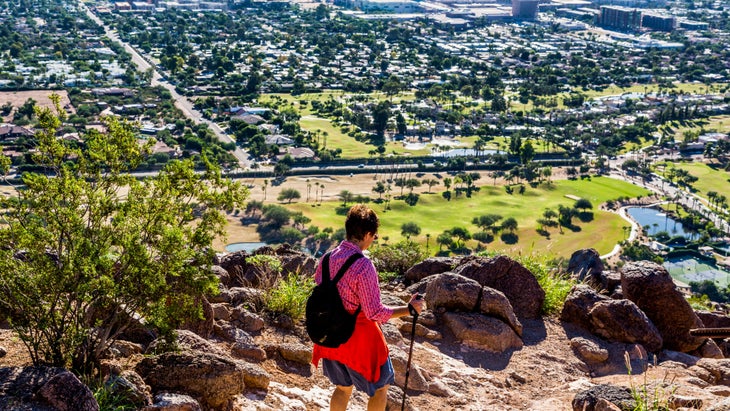
I spent a few days mountain biking and hiking in Phoenix and was absolutely green with envy at the town’s access to the outdoors. This city understands the value of public land, boasting more than 41,000 acres of desert parks and mountain preserves that feature over 200 miles of trails. These aren’t just grassy lawn parks. This is a legit desert-scape with mountains, with the Phoenix Sonoran Preserve, Camelbak Mountain, and the South Mountain Park and Preserve punctuating the cityscape with their peaks and ravines. Long, sinuous trail systems seem to start at the end of every neighborhood cul de sac.
There’s legitimately good hiking in all directions, but head to 16,000-acre South Mountain Park for my favorite hike. There, you can form a ten-mile loop through the east side of the park that uses the National Trail as its backbone and takes you through canyons, past massive rock outcroppings, and along ridgelines with big views. It’s a highlight tour of the Sonoran Desert, complete with plenty of surprisingly vibrant flora.
7. Boston, Massachusetts

Boston’s city-wide green space is unique because several key parks are connected in a line running through the heart of town. Revered landscape architect Frederick Law Olmsted designed the system of parks in the late 1800s, envisioning an artery of meadows, forests, creeks, and ponds within Boston’s concrete landscape. Today, the system—known as The Emerald Necklace—runs for seven miles, connecting seven different parks (from Franklin Park to Boston Common) and protecting 1,100 acres.
You can knock out a seven-mile thru-hike of the entire system on paved paths, or focus your energy on Franklin Park, Boston’s most expansive open space at 485 acres, and the park that Olmstead considered to be one of his greatest achievements. A 2.9-mile mostly paved loop will give you a good introduction, passing by Scarboro Pond and stands of old growth beech trees.
For a wilder experience, veer off the main path into an area dubbed “The Wilderness,” where more than a mile of intersecting singletrack and doubletrack explores a 65-acre forest of oaks, hemlocks, and rock outcroppings. The trails are also the backyard of the Appalachian Mountain Club, which protects and maintains trails throughout the Northeast and is headquartered in Franklin Park. The club uses The Wilderness area for urban hiking programs. Be sure to tackle the 99 Steps, a staircase carved out of local puddingstone on the edge of the small trail system.
8. San Diego, California

I spent a year living in San Diego in my early twenties. I was drawn to the city for its surf, but I spent a surprising amount of time hiking and running the trails around town. Southern California’s coolest city is sandwiched by epic terrain—the Pacific Ocean and its sandy beaches to the west and the Laguna Mountains to the east. In between, there are almost 40,000 acres of open space and more than 340 parks. Balboa Park is the city’s Central Park, at 1,200 acres, offering a mix of museums, manicured gardens, and trails. Mission Trails Regional Park (8,000 acres) is the city’s largest, with 65 miles of trails.
My favorite hike, and one that I feel is quintessentially San Diego, sits inside the small Sunset Cliffs Natural Park. At a mere 68 acres, Sunset Cliffs is easy to overlook, but the drama of the terrain will stick with you long after you leave. As the name implies, the park is home to a long band of cliffs on the Point Loma Peninsula jutting out into a rocky stretch of the Pacific Ocean. Combine the Main Trail with the Overlook Trail and the Sunset Cliffs Loop Trail for a 1.5-mile romp along the cliffs, past sandstone arches and unique rock formations. Definitely take the steps down to the tidepools and the small, sandy beach at the bottom of the park.
9. Atlanta, Georgia

I grew up in Atlanta and am constantly amazed at how wild the South’s busiest city can feel, thanks to the presence of its urban refuges. The city has put a lot of resources into building out its trail infrastructure, particularly the Atlanta Beltline, a project aimed at creating 33 miles of multi-use trail that connects existing parks and 1,300 acres of new green spaces throughout diverse neighborhoods.
What you might not know is that Atlanta has been dubbed “tree city” because of its dense canopy of hardwoods and pines. That canopy hides an extensive system of urban parks and trails that entice hikers looking for an escape. The Cascade Springs Nature Preserve is one such jewel of a park, protecting 120 acres of forest, creeks, and historic sites within a bustling southwest Atlanta neighborhood. Hike the 1.9-mile round trip Cascade Springs Trail through a hilly forest punctuated with mossy boulders and earthworks leftover from a Civil War battle. The highlight comes when the rocky Utoy Creek drops over a stone ledge forming a small waterfall. You might be amazed that a setting this serene could be found so close to the nearest Waffle House.
10. Portland, Oregon
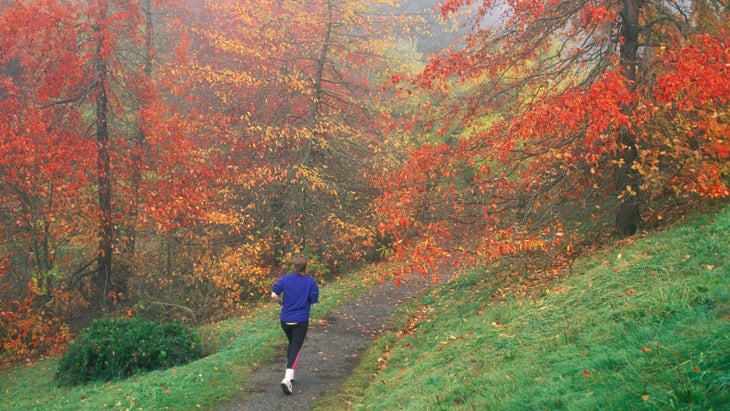
Is it any surprise that Portland puts a priority on parks? This Pacific Northwest city is arguably one of the most active with quick access to the rugged coast to the west and canyons and mountains to the east. The city itself is home to more than 12,000 acres of park land, with 150 miles of trail traversing it. The 40-Mile Loop connects a series of smaller parks and open spaces, and many of those trails can be reached by Portland’s TriMet bus system. Portland has an aggressive plan to expand the regional trail system and fill in the gaps, with a goal for the city and surrounding communities to be home to a 1,000-mile network of trails.
If you’re ready to hike right now, head to the aptly named Forest Park, which at 5,200 acres happens to be the largest urban forest in America, with 80 miles of trail traversing the mellow Tualatin Mountains. The 30-mile Wildwood Trail is the anchor of the system (it’s also designated a National Recreation Trail), running the length of the park. You can break the trail apart into sections—the Balch Creek Canyon is a popular destination for a short hike—or tackle the entire length. If you hike the whole thing, you’ll see the ruins of the Witch’s Castle, stands of towering redwoods, long range views of the Cascade Mountains, and meadows of wildflowers in the spring. You’ll also gain 2,800 feet along the way. Keep in mind you’ll have to knock it out in a day because there’s no camping inside the park.
11. Philadelphia, Pennsylvania
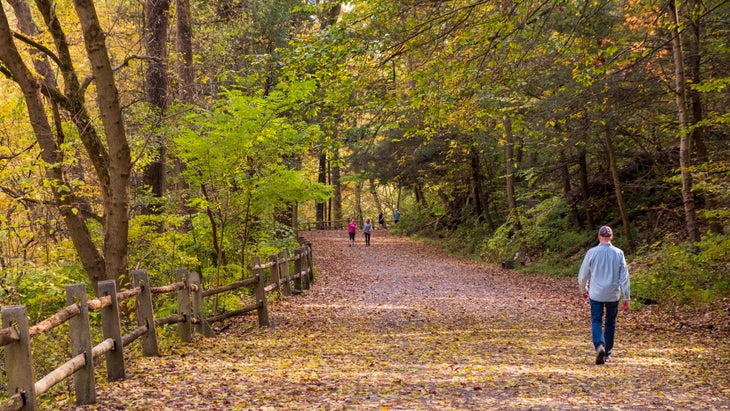
With more than 166 miles of trail spread across 300 city parks, Philadelphia is an urban hiker’s dream. The City of Brotherly Love even lays claim to the first urban wildlife refuge in the nation, the 1,000-acre John Heinze National Wildlife Refuge.
If you want city trails at their finest, head to Wissahickon Valley Park, an 1,800-acre wild space of river, forests, and gorges that’s accessible by Philadelphia’s rail and bus system. There are more than 50 miles of trail within the park, much of which is singletrack. You’ll get a solid dose of American history along with the rugged terrain of the gorge that the creek has carved. You’ll also see crumbling dams that were once part of paper mills and historic covered bridges that date back to the late 1700s.
Forbidden Drive, a wide, hard packed path that follows the creek, is the main thoroughfare through the park. It gets the most attention from walkers and cyclists, and it’s a good backbone to access other, more adventurous paths, like the 5.9-mile Orange Trail, which traces the edge of the creek. The tread is rocky and technical with some occasional scrambling. You’ll also be able to access Devil’s Pond, a swimming hole at the bottom of a short waterfall.
12. San Francisco, California
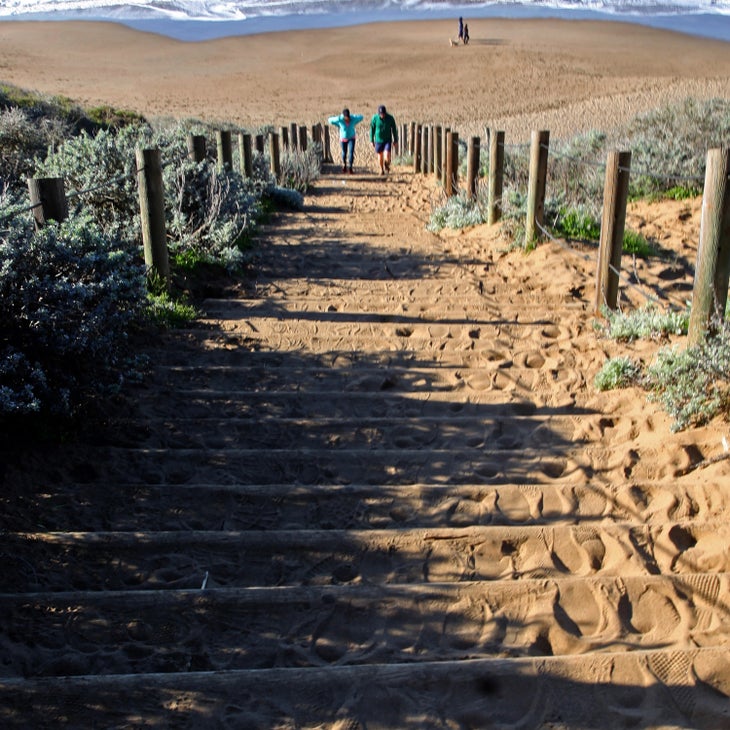
The hiking terrain within San Francisco’s city limits is legit. The 47-square-mile city encompasses a notoriously hilly stretch of California’s coastline, laying claim to the tip of a peninsula that divides the Pacific from the San Francisco Bay. According to the Trust for Public Land, every single city resident lives within a ten-minute walk to a park. There’s even a new 17-mile route, called the Crosstown Trail, that slices through the heart of the city connecting existing parks, paths, sidewalks, and community gardens. Meanwhile volunteers are hard at work building out the San Francisco Bay Trail, a planned 500-mile multi-use path that forms a ring around the Bay connecting 47 different cities.
For an epic hike on dirt that takes in the best of San Francisco’s dramatic terrain, focus on the Presidio, a 1,500-acre national park unit that protects a former military post at the heel of the Golden Gate Bridge. I stumbled onto the Presidio during a visit to San Francisco. My plan was to knock out a short, three mile run from my hotel to shake out a long day of travel, but I ended up running for almost 12 miles. I didn’t want to stop because the scenery was so good.
There are 24 miles of trail to explore, including a section of the 1,200-mile California Coastal Trail. The 2.7-mile portion that sits inside the Presidio’s borders starts at Baker Beach, a sandy nook facing the Pacific, before climbing to trace the edge of a rocky cliffline. The views of the Pacific are postcard worthy as you navigate the occasional stand of cypress before the trail ends near the Golden Gate Bridge. Options for side hikes deeper into the Presidio are plentiful, and you’ll also find side trails that drop from the cliffs to the water.
13. Seattle, Washington
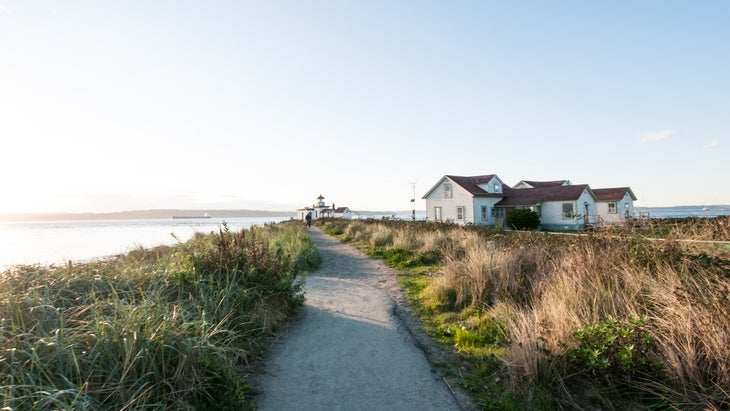
Last but hardly least, Seattle is basically a large inholding surrounded by public land. On one side of the city sits Olympic National Park, on the other, Mount Baker-Snoqualmie National Forest. A series of state forests sit to the south. You can even see Mount Rainier from the edge of town. You don’t need to catch a ferry or hit the highway to experience the outdoors. There are 120 miles of trails within city limits, from meandering greenways to lung-busting singletrack.
The best can be found inside Discovery Park, where 12 miles of trail explore 534 acres of lush forest on a bluff overlooking Puget Sound. The 2.8-mile Washington Trails Association Loop, a national recreation trail, will take you through the forest, where a dense undergrowth of ferns thrive in the shade, and through grassy meadows with long range views that take in the Puget Sound and Olympic Mountains on the horizon. Tack on short side hikes to beachy areas and the West Point Lighthouse.
Longtime Outside contributor Graham Averill grew up hiking and biking the trails around Atlanta, Georgia, and heads out on hikes in every city he visits. He now lives in Asheville, North Carolina.


